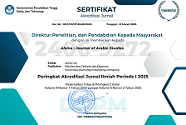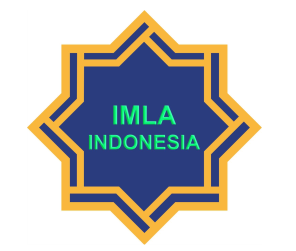Analisis Karakteristik Aplikasi Kamus Arab-Indonesia Karya Tim Ristek Muslim
DOI:
https://doi.org/10.21580/alsina.3.2.5938Keywords:
Application, Dictionary, Muslim Research and Technology TeamAbstract
This study is driven by the fact that Arabic is often seen as a complex language to master in many Indonesian schools and madrasas. This educational issue has resulted in various efforts to facilitate learning using meaningful innovations. The researchers created online and offline programs, including an Arabic-Indonesian dictionary built for Android. The current research tries to ascertain the applicability of the Arabic-Indonesian dictionary. This study is a literature review study using a descriptive qualitative approach. The developers (Surabaya Muslim Research and Technology Team) created the application in 2012 and used a variety of secondary sources, including articles, journals, and pertinent documents. The Arabic-Indonesian Dictionary is an Android-based Arabic-Indonesian dictionary application capable of translating Indonesian to Arabic and vice versa. This application database has 154,644 Arabic vocabularies. The dictionaries contained in this application include the Arabic-Indonesian Dictionary, Munawwir Dictionary, Muʿjam al-ʿArab, Muʿjam al-Muʿāṣirāh, Lisān al-ʿArabic, Muʿjam al-Ghanī, and the Al-Qur'an Dictionary. This dictionary can be used as an Arabic learning media.Downloads
References
Abū Sharīfah, ʿAbd al-Qādir, Ḥusain Lāfī, and Dāwūd Ghāṭāshah. ʿIlm Al-Dalālah Wa-Al-Muʿjam Al-ʿArabī. Amman: Dār al-Fikr, 1989.
Busro, Muh. “Sejarah Perkamusan bahasa Arab di Indonesia.” El-Wasathiya: Jurnal Studi Agama 4, no. 2 SE-Articles (December 27, 2016): 129–58. http://ejournal.kopertais4.or.id/mataraman/index.php/washatiya/article/view/2636.
Chaer, Abdul. Leksikologi Dan Leksikografi Indonesia. Jakarta: Rineka Cipta, 2007.
Harun, Uhame Binti. “Analisis Komponen Kamus Al-Mufied Indonesia-Arab Perspektif Dr. Ali Al-Qasimy.” In Prosiding Konferensi Nasional Bahasa Arab V, 639–47, 2019.
Hastang, Hastang. “Efektifitas Kamus Bahasa Arab Berbasis Aplikasi Android Dalam Menerjemahkan Qiraah.” Didaktika : Jurnal Kependidikan 11, no. 1 (2019): 112–20. https://doi.org/10.30863/DIDAKTIKA.V11I1.158.
Tim Ristek Muslim. “Kamus Arab Indonesia - Aplikasi Di Google Play.” Accessed May 2, 2020. https://play.google.com/store/apps/details?id=com.ristekmuslim.kamusarabindo&hl=in&gl=US.
Tim Ristek Muslim. “Kamus Arab Indonesia Android.” Accessed May 2, 2020. https://ristekmuslim.com/portofolio/kamus-arab-indonesia-android.
Keraf, Gorys. Diksi Dan Gaya Bahasa. Jakarta: Gramedia Pustaka Utama, 2004.
Mahridawati, Mahridawati. “Kamus Idiom Arab-Indonesia Pola Aktif Karya Basuni Imamuddin Dan Nashiroh Ishaq (Analisis Terhadap Metode Penyajian Kamus).” ITTIHAD 13, no. 24 (2015): 58–66. https://doi.org/10.18592/ITTIHAD.V13I24.1746.
Miles, Matthew B., A. Michael Huberman, and Johnny Saldana. Qualitative Data Analysis: A Methods Sourcebook. 3rd ed. California: SAGE Publications, Inc, 2014.
Rizani, Hadian. “Kamus Idris Al-Marbawi Dalam Tinjauan Leksikologi (Analisis Metode Dan Isi).” Alfaz (Arabic Literatures for Academic Zealots) 2, no. 2 (December 19, 2014): 223–37. http://jurnal.uinbanten.ac.id/index.php/alfaz/article/view/616.
Rustandi, Encep. “Kamus Dwibahasa Arab–Indonesia Untuk Pembelajar Pemula.” Edusentris: Jurnal Ilmu Pendidikan Dan Pengajaran 3, no. 2 (2016): 188–99. https://doi.org/10.17509/EDUSENTRIS.V3I2.217.
Sabirin, Abdul Rasyid, and Syaiful Taufik Watabetta. “Aplikasi Kamus Bahasa Arab-Indonesia Dan Indonesia-Arab Berbasis Android.” Jurnal Informatika 6, no. 1 (2017). http://ejournal.unidayan.ac.id/index.php/JIU/article/view/41.
Saehudin, Akhmad. “Tradisi Penyusun Kamus Arab: Telaah Kritis Tentang Sejarah Leksikografi Arab.” Buletin Al-Turas 11, no. 3 (2005): 220–28. https://doi.org/10.15408/BAT.V11I3.4201.
Tim Ristek Muslim. “Sejarah Pendirian Ristek Muslim.” Accessed April 15, 2020. https://ristekmuslim.com/sejarah-pendirian-ristek-muslim.
Sunarti, Lia, Ernawati Ernawati, and Marja’i Affan. “Aplikasi Kamus ViKA Sebagai Visualitator Kosakata Bahasa Arab Untuk Pembelajar Pemula.” Lisania: Journal of Arabic Education and Literature 1, no. 1 (2017): 37–55. https://doi.org/10.18326/LISANIA.V1I1.37-55.
Ya’qub, Emil. Al-Maʿājim Al-Lughawīyah Al-ʿArabīyah Badā’atuhā Wa-Taṭawwuruhā. Beirut: Dār al-Thaqāfah al-Islāmīyah, n.d.
Zahrah, Humairatuz, Wildana Wargadinata, and Nurhasan Abdul Barry. “Analisis E-Dictionarry ‘Arab-Indonesia’ Yang Tersedia Di Playstore Dengan Pendekatan Leksikologi.” Shaut Al Arabiyyah 9, no. 1 (June 2021): 1–10. https://doi.org/10.24252/SAA.V9I1.21494.
Zaini, Hisyam. “Al-Khalīl Dan Perannya Dalam Perkembangan Kamus Arab.” Adabiyyāt: Jurnal Bahasa Dan Sastra 3, no. 1 (2004).
Downloads
Published
How to Cite
Issue
Section
License
Copyright
The copyright of the received article shall be assigned to the publisher of the journal. The intended copyright includes the right to publish the article in various forms (including reprints). The journal maintains the publishing rights to published articles. Authors are allowed to use their articles for any legal purposes deemed necessary without written permission from the journal, but with an acknowledgment to this journal of initial publication.
Licensing
In order for Alsina: Journal of Arabic Studies to publish and distribute research articles, the editors need publishing rights (transferred from author to publisher). This agreement relates to the transfer/publishing copyright license to Alsina: Journal of Arabic Studies but the authors still have significant rights to use and share their published articles.
Alsina: Journal of Arabic Studies supports the need for writers to share, disseminate and maximize the impact of their research and their rights on any database. As a journal article writer, you have the right to various uses of your articles, including that by the institution or company where you work. Copyright can be used without the need for special permission. Authors who publish articles in the Alsina: Journal of Arabic Studies have broad rights to use their work for teaching and scientific purposes without requesting permission, including:
- Use by the author for lectures, presentations, or conferences, with distribution of copies to participants;
- Distribution to colleagues for research use;
- Use in compilations of the author's subsequent work;
- inclusion in a thesis or dissertation;
- Reuse of sections or excerpts from articles in other works (with full acknowledgment of the final article);
- Preparation of derivative works (other than commercial purposes) (with full acknowledgment of the final article);
- Voluntary posting on open websites operated by authors’ or writers' agencies for scientific purposes
When submitting a manuscript, authors do so on the understanding that if accepted for publication, the copyright for publishing (publishing right) of the article shall be assigned/transferred to Alsina: Journal of Arabic Studies.
Authors whose articles are accepted for publication will receive confirmation via email and sent a Copyright Transfer Agreement.


 Accreditation
Accreditation 
 In Collaboration with
In Collaboration with 

 Visitors
Visitors  Article Template
Article Template





